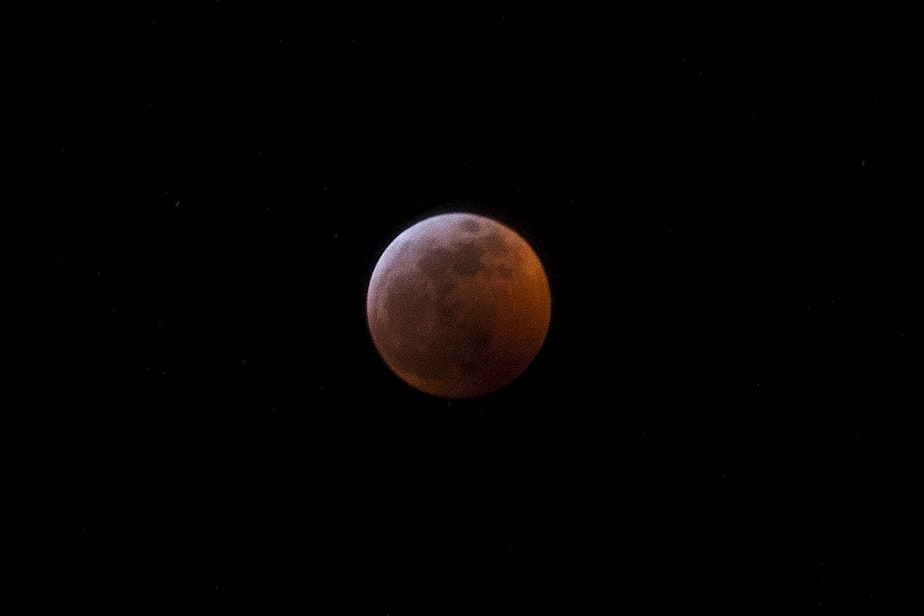Are you ready for a full, super, blue moon ... that might actually be red?

Blue moons aren't actually blue. Keep that in mind Wednesday, Aug. 30, when a very rare type of moon passes overhead.
What type of rare moon? Adding it all up, the moon will be a full moon, a supermoon, and a blue moon all at once. But again, "blue moon" is just a saying, which means something that doesn't happen very often. The moon won't actually be the color blue.
However ... since we are in the territory of rare occurrences, Alice Enevoldsen, an astronomy teacher at South Seattle College and a NASA solar system ambassador, noted that there is a (tiny) chance that conditions could align to actually give us a blue, blue moon.
"If you go out and you see the moon tomorrow night, if you get lucky, and you happen to see it through the clouds, and it does look blue, the reason for that is going to be a specific kind of wildfire smoke," Enevoldsen said. "If there are particulates in the air of about one micron, then that can actually filter the light that we're seeing and make it so that the moon will look blue, usually."
RELATED: How to watch a supermoon
This phenomenon is the same reason that the moon could look red or orange at night. It's because particulates in the air can scatter different wavelengths of light (similar to how light breaks into different colors when it passes through a prism, or ya know, like that Pink Floyd album cover). It's also why sunlight can look more red or orange. Enevoldsen noted that it's the size of the particulates that can influence what hue shines through.
"But if we happen to just have a gust of the right kind of smoke go across the moon, that would be one micron particulates, then we would actually see that blue color, which has nothing to do with the fact that it's a blue moon; that could happen at any time," she said. "It's absolutely mind boggling that there is a thing going on right now that could turn it blue, probably won't."
Again that's rare. It's more likely that, with the potential of wildfire smoke, the moon could appear red — a red ... full ... super... blue moon.
The moon rises shortly after 8 p.m. Wednesday, and sets around 7 a.m. Thursday morning. Even if the blue doesn't shine through, Wednesday's moon is still a rare sight to behold.
While it is close to a circle, the moon's orbit around the Earth is an elliptical journey (just like all orbits) — sometimes it is closer and sometimes it is farther away. On Wednesday, Aug. 30, the moon will be the closest to the Earth in its orbit. That makes it a supermoon.
"When it's slightly closer, and that occurs at the same time as a full moon, we call that a 'supermoon,'" Enevoldsen said. "It is slightly larger from our point of view, though you would need a telescope and take photographs in order to be able to measure that difference. It's not something you can just notice with your eye."
Enevoldsen said full moons come once a month, supermoons come a few times a year, but blue moons, at least by the modern definition, are the second full moon in a single month.
This doesn't happen too often, hence the phrase, "Once in a blue moon."
Another feature of Wednesday's moon will be in view around the Puget Sound region, but it won't be in the sky.
"When the moon is slightly closer to us, it is going to affect the tides ... so we're going to have a slightly lower than usual low [tide on Wednesday]," Enevoldsen said. "The highest [tide] is about the same though, but our low tide is going to be a little on the lower side. And that will be notable and noticeable, without any specialized equipment, so you can just go out and see that."
RELATED: Tidepool time! How you can explore Puget Sound’s shoreline during the lowest tides of the year
This week's super, full, blue moon (that might appear red) is also, sort of, like an opening act for another show in October.
Enevoldsen noted that there will be an annular solar eclipse on Saturday, Oct. 14, 2023. This is when the moon passes in front of the sun, leaving a little bit of sunlight around its edges. The full view of this eclipse will pass over Southern Oregon. Western Washington will get a view that is between 70-80%.
NOTE: DO NOT LOOK DIRECTLY AT AN ECLIPSE!
"What we'll be seeing from Seattle is a partial eclipse, if you want to see the full ring annular eclipse, you need to go down to Eugene, Oregon, or somewhere near there," Enevoldsen said. "But it'll be a significant partial eclipse from right here in Seattle, about 86% coverage, that starts at 8 a.m. in the morning, and it goes until about 10:30 a.m. in the morning, on Saturday, Oct. 14."
KUOW's John O'Brien interviewed Alice Enevoldsen and contributed to this article.

